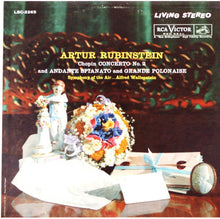Sonic Grade
Side One: 
Side Two: 
Vinyl Grade
Side One: Mint Minus Minus (closer to M-- to EX++ in parts)*
Side Two: Mint Minus Minus (closer to M-- to EX++ in parts)*
- Chopin's 2nd piano concerto returns to the site for only the second time in four years, here with stunning Nearly Triple Plus (A++ to A+++) sound from start to finish - just shy of our Shootout Winner
- The reproduction of the piano on this exceptional Shaded Dog pressing is clear, solid, and present - in other words, hard to fault
- The sound was simply bigger, more transparent, less distorted, more three-dimensional and more real than practically all the other copies we played
- We were also impressed with the vibrant orchestra surrounding the piano, with plenty of the Living Stereo Tubey Magical strings we audiophiles swoon over
More of the music of Frederic Chopin (1810-1849) / More Classical and Orchestral Recordings

100% Money Back Guarantee on all Hot Stampers
FREE Domestic Shipping on all LP orders over $150
*NOTE: There is a bubble in the vinyl that plays as 5 moderate thuds about 1/2 way into the first track / third movement on side 2.
*NOTE: This record was not noisy enough to rate our M-- to EX++ grade, but it's not quite up to our standards for Mint Minus Minus either. If you're looking for quiet vinyl, this is probably not the best copy for you.
These Nearly White Hot Stamper pressings have top-quality sound that's often surprisingly close to our White Hots, but they sell at substantial discounts to our Shootout Winners, making them a relative bargain in the world of Hot Stampers ("relative" meaning relative considering the prices we charge). We feel you get what you pay for here at Better Records, and if ever you don't agree, please feel free to return the record for a full refund, no questions asked.
The original version of LSC 2265 as pictured is known as The Rubinstein Story. It comes with a deluxe gatefold cover and a lovely illustrated booklet tucked into an inner flap with biographical information about Rubinstein and commentary about the music of Chopin. The second picture is of the reissue of the album which came out soon thereafter, still with the Shaded Dog label.
Those of you who know your Shaded Dogs no doubt have had a few problems with your Rubinstein pressings in the past being too midrangy and forward, a sound that Rubinstein supposedly insisted on for his records. Not so on this pressing, I am happy to report. The sound is overflowing with Tubey Magic.
This vintage RCA pressing has the kind of Tubey Magical Midrange that modern records can barely BEGIN to reproduce. Folks, that sound is gone and it sure isn't showing signs of coming back. If you love hearing INTO a recording, actually being able to "see" the performers, and feeling as if you are sitting in the studio with the band, this is the record for you. It's what vintage all analog recordings are known for -- this sound.
If you exclusively play modern repressings of vintage recordings, I can say without fear of contradiction that you have never heard this kind of sound on vinyl. Old records have it -- not often, and certainly not always -- but maybe one out of a hundred new records do, and those are some pretty long odds.
What The Best Sides Of This Wonderful Classical Recording Have To Offer Is Not Hard To Hear
- The biggest, most immediate staging in the largest acoustic space
- The most Tubey Magic, without which you have almost nothing. CDs give you clean and clear. Only the best vintage vinyl pressings offer the kind of Tubey Magic that was on the tapes in 1958
- Tight, note-like, rich, full-bodied bass, with the correct amount of weight down low
- Natural tonality in the midrange -- with all the instruments having the correct timbre
- Transparency and resolution, critical to hearing into the three-dimensional studio space
No doubt there's more but we hope that should do for now. Playing the record is the only way to hear all of the qualities we discuss above, and playing the best pressings against a pile of other copies under rigorously controlled conditions is the only way to find a pressing that sounds as good as this one does.
Size and Space
One of the qualities that we don’t talk about on the site nearly enough is the SIZE of the record’s presentation. Some copies of the album just sound small -- they don’t extend all the way to the outside edges of the speakers, and they don’t seem to take up all the space from the floor to the ceiling. In addition, the sound can often be recessed, with a lack of presence and immediacy in the center.
Other copies -- my notes for these copies often read “BIG and BOLD” -- create a huge soundfield, with the music positively jumping out of the speakers. They’re not brighter, they’re not more aggressive, they’re not hyped-up in any way, they’re just bigger and clearer.
And most of the time those very special pressings are just plain more involving. When you hear a copy that does all that -- a copy like this one -- it’s an entirely different listening experience.
What We're Listening For On Chopin's Piano Concerto #2
- Energy for starters. What could be more important than the life of the music?
- The Big Sound comes next -- wall to wall, lots of depth, huge space, three-dimensionality, all that sort of thing.
- Then transient information -- fast, clear, sharp attacks, not the smear and thickness so common to these LPs.
- Powerful bass -- which ties in with good transient information, also the issue of frequency extension further down.
- Next: transparency -- the quality that allows you to hear deep into the soundfield, showing you the space and air around all the instruments.
- Extend the top and bottom and voila, you have The Real Thing -- an honest to goodness Hot Stamper.
Vinyl Condition
Mint Minus Minus is about as quiet as any vintage pressing will play, and since only the right vintage pressings have any hope of sounding good on this album, that will most often be the playing condition of the copies we sell. (The copies that are even a bit noisier get listed on the site are seriously reduced prices or traded back in to the local record stores we shop at.)
Those of you looking for quiet vinyl will have to settle for the sound of other pressings and Heavy Vinyl reissues, purchased elsewhere of course as we have no interest in selling records that don't have the vintage analog magic of these wonderful recordings.
If you want to make the trade-off between bad sound and quiet surfaces with whatever Heavy Vinyl pressing might be available, well, that's certainly your prerogative, but we can't imagine losing what's good about this music -- the size, the energy, the presence, the clarity, the weight -- just to hear it with less background noise.
Side One
- Concerto No. 2 In F Minor, Op. 21
- First Movement: Maestoso
- Second Movement: Larghetto
Side Two
- Concerto No. 2 In F Minor, Op. 21
- Third Movement: Allegro Vivace
- Andante Spianato And Grande Polonaise In E-Flat, Op. 22
Chopin's Piano Concerto No. 2
The Piano Concerto No. 2 in F minor, Op. 21, is a piano concerto composed by Frédéric Chopin in 1829. Chopin wrote the piece before he had finished his formal education, at around 20 years of age. It was first performed on 17 March 1830, in Warsaw, Poland, with the composer as soloist. It was the second of his piano concertos to be published (after the Piano Concerto No. 1), and so was designated as "No. 2," even though it was written first.
-Wikipedia


